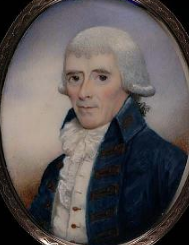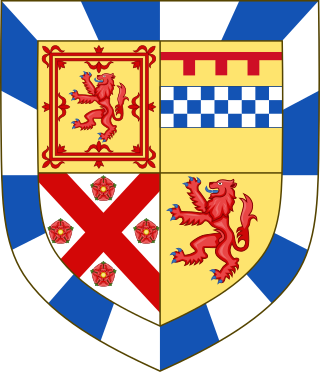Related Research Articles

John Knox was a Scottish minister, Reformed theologian, and writer who was a leader of the country's Reformation. He was the founder of the Presbyterian Church of Scotland.
Archibald Campbell, 5th Earl of Argyll was a Scottish nobleman, peer, and politician. He was one of the leading figures in the politics of Scotland during the reign of Mary, Queen of Scots, and the early part of that of James VI.

The Lords of the Congregation, originally styling themselves the Faithful, were a group of Protestant Scottish nobles who in the mid-16th century favoured a reformation of the Catholic church according to Protestant principles and a Scottish-English alliance.

Earl of Glencairn was a title in the Peerage of Scotland. It was created in 1488 for Alexander Cunningham, 1st Lord Kilmaurs. The name was taken from the parish of Glencairn in Dumfriesshire so named for the Cairn Waters which run through it.

James Cunningham, 14th Earl of Glencairn was a Scottish nobleman, soldier and patron of Robert Burns.
William Cunningham, 4th Earl of Glencairn, 5th Lord of Kilmaurs was a Scottish nobleman, soldier, and "notorious intriguer".
Alexander Cuninghame, 1st Earl of Glencairn, 1st Lord Kilmaurs was a Scottish nobleman.

William Cunningham, 9th Earl of Glencairn (1610–1664), was a Scottish nobleman, Lord Chancellor of Scotland, and a cavalier. He was also the chief of Clan Cunningham.
John Willock was a Scottish reformer. He appears to have been a friar of the Franciscan House at Ayr. Having joined the party of reform before 1541, he fled for his life to England. There he became noted as a zealous and taking preacher. This led to his arrest for heresy under an Act of Henry VIII., "for abolishing diversity of opinion" in matters of religion. He was found guilty of preaching against purgatory, holy water, priestly confession, and prayer to the saints, and of holding that priests might lawfully be married, he was for some time confined in the Fleet prison. After the accession of Edward VI he was chaplain to Henry, Duke of Suffolk, who had married King Henry's niece, and is best known as the father of Lady Jane Grey. He preached for a time in London, in St Katherine's Church, when both he and John Knox, his fast friend, were granted general license to preach anywhere in England. Henry, Earl of Huntingdon, presented him to the rectory of Loughborough in Leicestershire, a living which he continued to hold during King Edward's reign, and again during that of Queen Elizabeth for the rest of his life. Thus in his later years he was in the unique position of being at the same time a parish minister in both England and Scotland. When Mary Tudor came to the English throne in 1553, Willock fled to Embden, in the Protestant Duchy of Friesland. There he practised as a physician with much success, and rose to some eminence. In 1555, and again in 1556, the Duchess Anne of Friesland sent him to Scotland as her Commissioner on matters of trade. In 1558 he returned home, and preached for some time in Dundee, with much acceptance among the friends of reform. In 1559, when John Knox had to leave Edinburgh in peril of his life, Willook took his place as the evangelist of the Reformation. It was then that he conducted in St Giles what is believed to have been the earliest public celebration of the Holy Communion in Scotland after the reformed ritual. In 1560, when Queen Mary of Guise lay dying, the Earls of Argyll and Moray, and other Lords of the Congregation advised her to "send for a godly, learned man of whom she might receive instruction"; and Willock was chosen to minister to her, which he faithfully did. That same year he was made Superintendent of Glasgow and the West. He was also one of the six Johns entrusted with the drawing up of the First Book of Discipline, the others being John Knox, John Winram, John Spottiswood, John Douglas, and John Row. Sometime in that year he went to England, and brought home his wife, Katherine Picknavell, an English lady. He was chosen Moderator of the General Assembly in 1563, 1564, 1565, and 1568. In 1565 Queen Mary endeavoured to put a stop to his activity by having him imprisoned in Dumbarton Castle; but the Reformers were now too strong for her, and she had to depart from her purpose.

Clan Cunningham is a Scottish clan. The traditional origins of the clan are placed in the 12th century. However, the first contemporary record of the clan chiefs is in the thirteenth century. The chiefs of the Clan Cunningham supported Robert the Bruce during the Wars of Scottish Independence. In the 15th and 16th centuries, the Clan Cunningham feuded with the Clan Montgomery. Historically, the chief of Clan Cunningham held the title of Earl of Glencairn. However, in modern times the chief of the clan is Cunningham of Corsehill. On 18 December 2013, Sir John Christopher Foggo Montgomery Cunninghame, Baronet of Corsehill, was recognized by Lord Lyon as Clan Chief after the chiefship had been vacant for over 200 years.
The Battle of Carberry Hill took place on 15 June 1567, near Musselburgh, East Lothian, a few miles east of Edinburgh, Scotland. A number of Scottish lords objected to the rule of Mary, Queen of Scots, after she had married the Earl of Bothwell, who was widely believed to have murdered her previous husband Lord Darnley. The Lords were intent to avenge Darnley's death. However, Bothwell escaped from the stand-off at Carberry while Queen Mary surrendered. Mary abdicated, escaped from prison, and was defeated at the battle of Langside. She went to exile in England while her supporters continued a civil war in Scotland.
James Cunningham, 7th Earl of Glencairn (1552–1630) was a Scottish peer and member of the Privy Council of Scotland.
Kilmaurs Place, The Place or Kilmaurs House, is an old mansion house and the ruins of Kilmaurs Tower grid reference NS41234112 are partly incorporated, Kilmaurs, East Ayrshire, Scotland. The house stands on a prominence above the Carmel Water and has a commanding view of the surrounding area. Once the seat of the Cunningham Earls of Glencairn it ceased to be the main residence after 1484 when Finlaystone became the family seat. Not to be confused with Kilmaurs Castle that stood on the lands of Jocksthorn Farm.
Margaret Knox was a Scottish noblewoman and the second wife of Scottish reformer John Knox, whom she married when she was 17 years old and he 54. The marriage caused consternation from Mary, Queen of Scots, as the couple had married without having obtained royal consent.
Sir James MacGill, Lord Rankeillor of Nether Rankeillour, was a Scottish courtier and Senator of the College of Justice.

The Battle of Glasgow was fought on 16 March 1544, between Matthew Stewart, 4th Earl of Lennox and the Scottish Regent James Hamilton, 2nd Earl of Arran, and their adherents, during the minority of Mary, Queen of Scots. There was a second battle at Glasgow Muir in May 1544, known as the Battle of the Butts, between Arran and the Earl of Glencairn.

Andrew Stewart, 2nd Lord Ochiltree fought for the Scottish Reformation. His daughter married John Knox and he played a part in the defeat of Mary, Queen of Scots at the battle of Langside.

Finlaystone House is a mansion and estate in the Inverclyde council area and historic county of Renfrewshire. It lies near the southern bank of the Firth of Clyde, beside the village of Langbank, in the west central Lowlands of Scotland.
Sir John Wishart of Pitarrow was a Scottish lawyer, courtier, comptroller of the exchequer, and rebel.

The Glencairn Aisle or Glencairn Vault at Kilmaurs, East Ayrshire is a Category B Listed vaulted sepulchral chapel built as a place for private contemplation and prayer that also contains a large memorial monument, as well as the burial crypt of the Cunningham Earls of Glencairn and their family members. An 'Aisle' is defined as a structure normally attached to a church, which may have burial crypt below, a family pew above, and sometimes a retiring room as at the Glencairn Aisle.
References
- ↑ "Alexander Cunningham, 5th earl of Glencairn". Britannica. Retrieved 6 March 2020.
- ↑ Charles Rogers, History of the Chapel Royal of Scotland (Edinburgh, 1882), p. ccxl: Herries, Historie of the Reigne of Marie Queen of Scots (Edinburgh, 1836), p. 97.
- ↑ Murray, James (1907). Kilmacolm. A Parish History. Alexander Gardner. p. 219.
- ↑ Macdonald, William Rae, Scottish Armorial Seals, (Edinburgh: W. Green, 1904), p 67